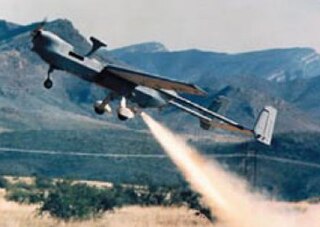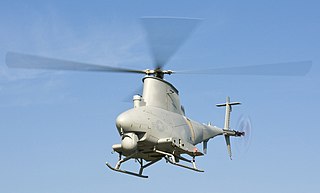Related Research Articles

The Lockheed AC-130 gunship is a heavily armed, long-endurance, ground-attack variant of the C-130 Hercules transport, fixed-wing aircraft. It carries a wide array of ground-attack weapons that are integrated with sophisticated sensors, navigation, and fire-control systems. Unlike other modern military fixed-wing aircraft, the AC-130 relies on visual targeting. Since its large profile and low operating altitudes around 7,000 feet make it an easy target, its close air support missions are usually flown at night.

The IAI RQ-5 Hunter unmanned aerial vehicle (UAV) was originally intended to serve as the United States Army's Short Range UAV system for division and corps commanders. It took off and landed on runways. It used a gimbaled EO/IR sensor to relay its video in real time via a second airborne Hunter over a C-band line-of-sight data link. The RQ-5 is based on the Hunter UAV that was developed by Israel Aerospace Industries.
The Joint Direct Attack Munition (JDAM) is a guidance kit that converts unguided bombs, or "dumb bombs", into all-weather precision-guided munitions. JDAM-equipped bombs are guided by an integrated inertial guidance system coupled to a Global Positioning System (GPS) receiver, giving them a published range of up to 15 nautical miles (28 km). JDAM-equipped bombs range from 500 to 2,000 pounds. The JDAM's guidance system was jointly developed by the United States Air Force and United States Navy, hence the "joint" in JDAM. When installed on a bomb, the JDAM kit is given a GBU identifier, superseding the Mark 80 or BLU nomenclature of the bomb to which it is attached.

Paveway is a series of laser-guided bombs (LGBs).

A laser-guided bomb (LGB) is a guided bomb that uses semi-active laser guidance to strike a designated target with greater accuracy than an unguided bomb. First developed by the United States during the Vietnam War, laser-guided bombs quickly proved their value in precision strikes of difficult point targets. These weapons use on-board electronics to track targets that are designated by laser, typically in the infrared spectrum, and adjust their glide path to accurately strike the target. Since the weapon is tracking a light signature, not the object itself, the target must be illuminated from a separate source, either by ground forces, by a pod on the attacking aircraft, or by a separate support aircraft.

A laser designator is a laser light source which is used to designate a target. Laser designators provide targeting for laser-guided bombs, missiles, or precision artillery munitions, such as the Paveway series of bombs, AGM-114 Hellfire, or the M712 Copperhead round, respectively.

Boeing Defense, Space & Security (BDS) is a division of The Boeing Company based in Arlington, Virginia, near Washington, D.C. The division builds military airplanes, rotorcraft, and missiles, as well as space systems for both commercial and military customers, including satellites, spacecraft, and rockets.
Hunter-Killer is an unofficial project name based upon an Aviation Week & Space Technology article. The U.S. Air Force's Hunter-Killer program was a tactical unmanned combat air vehicles (UCAV) procurement program. The General Atomics MQ-9 Reaper, a variant of the MQ-1 Predator won the project and was deployed in Afghanistan.
The GBU-37 Global Positioning System Aided Munition (GAM) was developed for use with the B-2 Bomber. The bomb can penetrate hardened targets or targets buried deep underground. The first all-weather precision-guided bunker buster, it became operational in 1997. It has been replaced on the B-2 by the 5,000-pound GPS-aided/INS-guided GBU-28.

The GBU-57A/BMassive Ordnance Penetrator (MOP) is a precision-guided, 30,000-pound (14,000 kg) "bunker buster" bomb used by the United States Air Force. It is substantially larger than the deepest-penetrating bunker busters previously available, the 5,000-pound (2,300 kg) GBU-28 and GBU-37.

A guided bomb is a precision-guided munition designed to achieve a smaller circular error probable (CEP).

The Northrop Grumman MQ-8 Fire Scout is an unmanned autonomous helicopter developed by Northrop Grumman for use by the United States Armed Forces. The Fire Scout is designed to provide reconnaissance, situational awareness, aerial fire support and precision targeting support for ground, air and sea forces. The initial RQ-8A version was based on the Schweizer 330, while the enhanced MQ-8B was derived from the Schweizer 333. The larger MQ-8C Fire Scout variant is based on the Bell 407.

The General Atomics MQ-9 Reaper is an unmanned aerial vehicle capable of remotely controlled or autonomous flight operations, developed by General Atomics Aeronautical Systems (GA-ASI) primarily for the United States Air Force (USAF). The MQ-9 and other UAVs are referred to as Remotely Piloted Vehicles/Aircraft (RPV/RPA) by the USAF to indicate ground control by humans.
GBU may refer to:
The Northrop Grumman Brilliant Anti-Tank (BAT) is a United States submunition round dispensed from a missile. It is capable of independently identifying and attacking armored vehicles. The BAT uses acoustic sensors to identify its intended targets, and an infrared homing (IR) terminal seeker to image and aim at the attack target.

The AGM-176 Griffin is a lightweight, precision-guided munition developed by Raytheon. It can be launched from the ground or air as a rocket-powered missile or dropped from the air as a guided bomb. It carries a relatively small warhead, and was designed to be a precision low-collateral damage weapon for irregular warfare. It has been used in combat by the United States military during the War in Afghanistan.

A precision-guided munition (PGM), also called a smart weapon, smart munition, or smart bomb, is a guided munition intended to hit a specific target, to minimize collateral damage and increase lethality against intended targets. During the Persian Gulf War guided munitions accounted for only 9% of weapons fired, but accounted for 75% of all successful hits. Despite guided weapons generally being used on more difficult targets, they were still 35 times more likely to destroy their targets per weapon dropped.

The GBU-53/B StormBreaker, previously known as the Small Diameter Bomb II, is an American air-launched, precision-guided glide bomb.

The GBU-39/B Small Diameter Bomb (SDB) is a 250-pound (110 kg) precision-guided glide bomb that is intended to provide aircraft with the ability to carry a higher number of more accurate bombs. Most US Air Force aircraft will be able to carry a pack of four SDBs in place of a single 2,000-pound (910 kg) bomb. It first entered service in 2006. The Ground Launched Small Diameter Bomb (GLSDB) was later developed to enable the SDB to be launched from a variety of ground launchers and configurations.

A loitering munition, also known as a suicide drone, kamikaze drone, or exploding drone, is a kind of aerial weapon with a built-in warhead that is typically designed to loiter around a target area until a target is located, then attack the target by crashing into it. Loitering munitions enable faster reaction times against hidden targets that emerge for short periods without placing high-value platforms near the target area and also allow more selective targeting as the attack can be changed mid-flight or aborted.
References
- ↑ "Viper Strike Laser Guided Weapon for UAVs". Defense Update. 2005-09-25. Archived from the original on 2013-02-13. Retrieved 2013-01-20.
- ↑ Viper Strike Scores Direct Hits in US Army-Northrop Tests - Deagel.com, April 9, 2003
- ↑ Greater Launch Altitude for Viper Strike - Deagel.com, June 15, 2005
- ↑ Hunter-Viper Strike Completes Testing at White Sands Missile Range - Deagel.com, February 28, 2007
- ↑ Viper Strike in service - Strategypage.com, April 7, 2009
- ↑ Hunter Unmanned Air System Successfully Completes GPS-guided Viper Strike Testing - Deagel.com, September 1, 2009
- ↑ Viper Strike Being Added to US Marines KC-130J Aircraft Arsenal - Deagel.com, June 2, 2010
- ↑ VIPER STRIKE SCORES MULTIPLE DIRECT HITS FROM USMC'S KC-130J HARVEST HAWK Archived 2012-07-10 at the Wayback Machine - MBDA press release, April 16, 2012
- ↑ MBDA’S Viper Strike Munition Scores Direct Hits Against High Speed Targets - MBDA press release, September 4, 2012
- ↑ MBDA demonstrates Viper Strike against faster ground targets - Janes.com, 4 September 2012
- ↑ Commandos Buying Thousands of Small Missiles That Pack A Bigger Punch Than Hellfires. Breaking Defense. 11 May 2018.
- ↑ "Northrop Grumman BQM-155/RQ-5/MQ-5 Hunter". www.designation-systems.net.
- ↑ "Northrop Grumman press release".
- ↑ Rogoway, Tyler. "The U.S. Air Force's New AC-130 Gunships Are Really Bomb Trucks" . Retrieved 1 November 2018.
- 1 2 3 "Viper Strike Overview" (PDF). dtic.mil. Archived from the original (PDF) on 2009-09-02. Retrieved 2007-07-21.
- ↑ "Viper Strike". Deagel. Retrieved 2013-01-20.
- ↑ "Northrop Grumman Demonstrates Viper Strike Precision Munition Enhanced with GPS".
- ↑ Borden, Steve (11 March 2009). "Small Guided Munitions – Path Ahead Small Guided Munitions – Path Ahead" (PDF). Small Guided Munitions Production Office. Retrieved 1 November 2018.